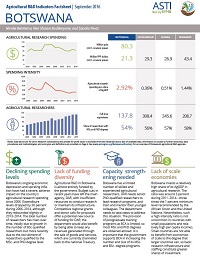Authors:
Nienke Beintema, Neo Sharon Bodilenyane, and Sandra Perez
Year:
2016
Publisher
International Food Policy Research Institute and Department of Agricultural Research
Back to:
Declining spending levels
Botswana’s ongoing economic depression and spiraling inflation have had a severe, adverse impact on the country’s agricultural research spending since 2006. Expenditure levels dropped by 30 percent during 2006–2014, although they rebounded slightly in 2013–2014. The total number of researchers has risen over time, intially due to growth in the number of BSc-qualified researchers but more recently due to the recruitment of researchers qualified to the MSc- and PhD-degree level.
Lack of funding diversity
Agricultural R&D in Botswana is almost entirely funded by the government. Budget cuts in recent years have left the main agency, DAR, with insufficient resources to conduct research or maintain its infrastructure. Competitive regional grants and donor calls for proposals offer a potential new source of funding for DAR; the department would also benefit by being able to keep any revenues generated through the sale of goods and services, which are currently channeled back to the national Treasury.
Capacity strengthening needed
Botswana has a limited number of skilled and experienced agricultural researchers. DAR needs senior PhD-qualified researchers to lead research programs, and train and mentor their younger colleagues. The department needs to take steps to address this situation. The provision of postgraduate training programs at BCA is limited, so most MSc and PhD degrees are obtained abroad. It is important that the government supports BCA in increasing the number and size of its MScand BSc- degree programs.
Lack of scale economies
Botswana invests a relatively high share of its AgGDP in agricultural research. The ratio was around 3 percent during 2011–2014—three times the 1 percent minimum level recommended by the African Union and the United Nations. Nevertheless, such a high intensity ratio is not uncommon in countries with small populations and relatively high per capita incomes. Small countries are not able to benefit from economies of scale to the degree that larger countries can, so basic research infrastructure and staffing constitute greater shares of investment.

